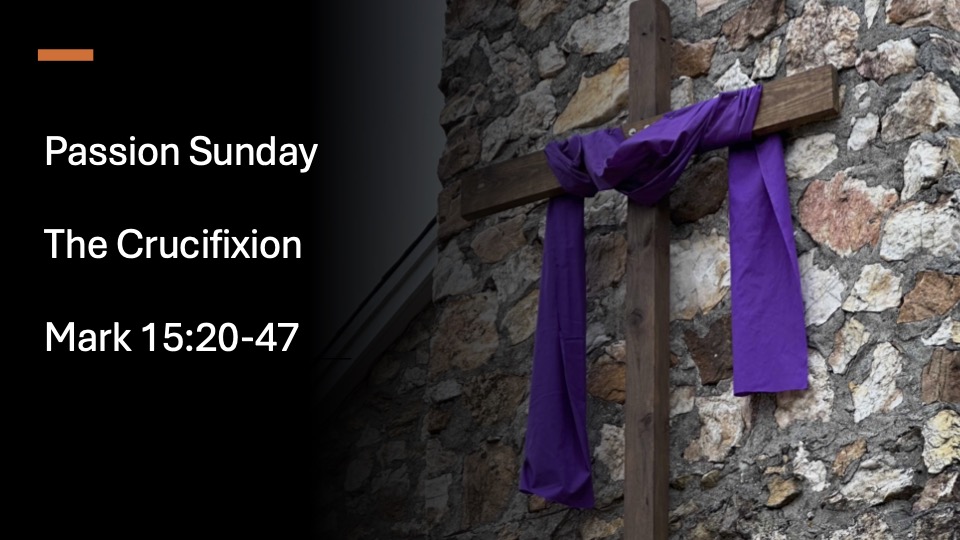Jeff Garrison
Mayberry & Bluemont Churches
March 23, 2024
Mark 15:20-47
Introduction at the beginning of Worship:
Over the past few weeks, I have read two books most people would consider totally dissimilar. Both I reviewed in my blog this week.[1] One is the novel by Chimamanda Ngogi Adichie, a Nigerian born author, titled Half a Yellow Sun. The story, set in the 1960s, takes the reader from shortly after Nigeria received its independence from Britain through the Biafran Civil War.
The second book is The Garden of the Beasts by Erik Larson. He’s a favorite author of mine who writes non-fiction which reads like a novel. The Garden of the Beast is about the American ambassador Franklin Roosevelt appointed to Germany in 1933. Hitler had just taken over and Roosevelt had a hard time finding someone to assume the position. He ended up with William Dodd, a historian and academic who had spent a few years studying in Germany. Dodd took his family, and the book mostly focuses on his and his daughter, Martha’s, experiences. Do you see what I mean by dissimilar.
The inhumanity shown in both books
But both books show us how inhumane people can be toward others. In Half a Yellow Sun, the Igbo people are slaughtered in Nigeria, especially in the mostly Muslim north. The terror these people experienced was horrifying. As a result, they tried to pull away from Nigeria and create their own country. And the war was equally horrifying. We, as Americans, probably know less about the war because we were up to our necks in Vietnam at the time.
Of course, we all know what happened in Germany. Dodd and his family were there at the very beginning. No one would listen to his warnings about just how bad things might become as Hitler militarizes the German people and scapegoats the Jews.
Both books deal with a group of people demonized by those in power: the Jews and the Igbo. Sometimes, it is hard to realize that people can be so evil. But it continues. After the holocaust and Biafra, we’ve had the Kimber Rouge in Cambodia, the ethnic wars in Bosnia, the killings in Rwanda, and most recently the Russian strikes against civilian targets in Ukraine, the horrific Gazan attack in Israel followed by Israel’s brutal revenge in Gaza, and this weekend terrorist attacks on Russia.
Our world is a mess. But this should not be surprising for Christians. For we believe in a God who came to us and unjustly suffered a horrific death at human hands.
Palm or Passion Sunday?
Today is known as Palm Sunday, but it’s also Passion Sunday. We’re focusing on the latter. When you jump from the celebration of Jesus’ entry into Jerusalem, Palm Sunday, to Easter morning, you skip the ugly side of humanity. The crucifixion is the central focus of our faith. It shows, not just our capacity for evil, but also God’s love which forgives our sinfulness and defeats death and evil.
Introduction to the Scriptures
We’re jumping forward in Mark’s gospel, skipping over 12 chapters. I’ll come back to the rest of the gospel after Easter. Today, as I said, we’ll hear about the crucifixion of Jesus. I am going to break up the scripture into three readings. A different person will read each passage, and then I will follow the reading with brief reflections.
This is a long piece of scripture, from the 15th chapter of Mark’s gospel, which begins with Jesus being led to his crucifixion and ends with his burial in the tomb. Before the first reading we learn of Jesus’ mocking by the Roman soldiers. Ironically, they call him the King of the Jews, but we discover he’s the King of Kings.[2]
Mark builds up to the Jesus’ death going back to the Pharisees and Herodians conspiracy at the beginning of the 3rd Chapter.[3]
Mark’s account of the crucifixion is brief. As one of my professors wrote in his commentary on Mark, “Jesus is not portrayed as a model of courageous faith to be imitated but as a unique instance in the history of God’s saving activity.” As Mark has already informed us, Jesus’ death is a ransom for many.[4]
In our service this morning, different people will read the various texts of scripture.
Morning: Mark 15:20-32
readers: Leslie Shelor/Jerry Potter
Reflections
One of the interesting things about Mark’s description of the crucifixion is that he doesn’t focus on Jesus. Instead, Mark focuses on those around Jesus, at least at first.[5] You have the soldiers who compel a foreigner in the crowd, an African, to take the cross. We’re not given a reason and left to assume that Jesus physical state was such he’d died before he got to the place of execution.
Once on the hill, they strip his clothes and gamble for them, which fulfills prophecy.[6] Refusing the drink designed to deaden his pain is Jesus’ only actions.[7] Everyone mocks Jesus: the religious leaders, those passing by, and even those crucified with him. One is crucified to this right, the other to his left. The staging of the crucifixion reminds Mark’s audience of James and John’s request to be on the right and left hand of Jesus in God’s kingdom.[8]
There’s irony in the mocking of Jesus. They all speak of Jesus not being able to save himself, not realizing that through his death he open salvation to all.
Afternoon: Mark 15:33-41
reader: Jack Palmer/Libby Wilcox
Reflections
Things around the cross change in the afternoon. First, the taunting from the morning disappears. Something strange happens. Darkness descends over the land. This is not a natural phenomenon, such as an eclipse. An eclipse would be quickly over and occurs during a new moon. The Passover always falls on the full moon. God called forth the darkness,[9] almost as if cosmos returns to its pre-creation state of chaos.[10]
Only now, does Jesus speak. But it’s not the gentle voice of our Shepherd Savior. Instead, we hear the agony of a man in pain. Jesus carries the weight of the world’s sorrows. Mark gives us both the Aramaic phrased cried out by Jesus along with a translation. He’s quotes 22nd Psalm, asking why he’s been forsaken. Jesus feels totally abandoned.
But those watching don’t understanding. Because of the cry, they think Jesus calls on Elijah to come save him. Someone wants to give Jesus something to drink, perhaps thinking a bit of moisture in his mouth would make his cry more understandable. But others want to wait, curious if Elijah will show up. Because Elijah didn’t die but was taken up into sky in a fiery chariot,[11] it was thought he could back to rescue the faithful.[12]
But it doesn’t matter. Exhausted, Jesus cries out in pain and dies. The curtain in the temple splits. Mark doesn’t interpret this for us, but again we see Jesus is doing something new. The wall between God and us, symbolized by the curtain, has been torn down.[13]
We’re given two reactions to Jesus’ death. The first comes from the Roman soldier assigned to Jesus’ execution, who having experienced everything of the day, acknowledges Jesus as God’s son. While some question the meaning of the soldier’s words, the idea that a deified man would undergo such treatment would have been a scandal to anyone: Jew, Greek, Roman or barbarian. It would have been considered foolish.[14]
Did the soldier’s statement come from a revelation he had into the mystery of our faith?[15] If so, it would be just like Jesus, the one who encourages us to love and pray for our enemies and persecutors,[16] to have the first post crucifixion conversion be the one responsible for his execution. If that’s the case, there’s hope for us all.
I have a feeling when we arrive in the kingdom, we’ll all be surprised by some of the others in heaven.
The women are the second reaction. These women followed and supported his ministry. Now they gather to watch from a distance. While they don’t say anything, we’ll see them at the beginning of chapter 16 bringing spices to anoint Jesus’ body. This action reinforces the idea of Jesus’ death. Once death descends, hope dies. They honor him by preparing his body and then will attempt to pick up their lives and continue.
Evening Mark 15: 42-47
readers: Barbara Wagoner/Jeff Garrison
Reflections
Our final scene is Jesus’ burial. Normally, the Romans kept bodies of those executed exposed. Crucifixion reminded everyone of Rome’s power. The message, “Don’t mess with Rome” was visually reinforced. The body remained to warn others. It was left to decay and to be picked at by birds.
However, Rome was also practical and knew this went against Jewish sensibilities. The Hebrew scriptures forbid abusing the bodies of the deceased. Even a criminal deserved burial.[17]
Wanting to keep the peace, Pilate, after making sure Jesus was dead, allows Joseph of Arimathea to take Jesus’ body and bury it. Furthermore, as the Sabbath approaches, this meant they had to work quickly to get the body into a tomb before the sun set.
Mark sets the stage for what happens next. The women watch They know where to go on the day after the Sabbath.
Mark’s account of the crucifixion contains numerous reminders of Jesus’ death. He didn’t want his readers to think that perhaps the disciples took Jesus off the cross while still alive and, after a few days, recovered.[18] Dead and buried, Jesus takes our sin to the grave. He pays the ramson for our sin through this horrific death.
Death by crucifixion was ugly and messy. It displays the worse of human behavior. Yet we know it’s not the final word. The crucifixion shows the extent God will go to reach a fallen human race. Somehow, through Jesus’ death, our sins are forgiven. We are freed from that burden and opened to the hope we’ll experience on Easter Sunday. Amen.
[1] https://fromarockyhillside.com/2024/03/20/two-books-which-remind-us-of-the-reality-of-human-depravity/
[2] Douglas R. A. Hare, Westminster Bible Companion: Mark (Louisville: KY: WJKP, 1996), 210. See also Revelation 17:14, 19:16).
[3] Mark 3:1-6. See my sermon on this passage at https://fromarockyhillside.com/2024/03/10/the-plot-against-jesus/
[4] Hare, 211. Mark 10:45.
[5] Hare, 2011.
[6] Psalm 22:18.
[7] See Psalm 69:21. Luke links this drink to a charitable act by the women of Jerusalem, Luke 23:28.
[8] Mark 10:27
[9] Hare, 215. James R. Edwards, The Gospel According to Mark (Grand Rapids, MI: Eerdmans, 2002), 475. The crucifixion happened during the Passover which falls on the full moon. Edwards also rules out a dust storm, but the spring is the rainy season in Palestine.
[10] See Genesis 1:1-2.
[11] 2 Kings 2:1-12.
[12] Morna D. Hooker, The Gospel According to Saint Mark (1991, Hendrickson Publishing, 1997), 376.
[13] See Hebrews 9:1-5.
[14] 1 Corinthians 1:22-25.
[15] Edwards, 480-481.
[16] Matthew 5:43-44.
[17] Deuteronomy 21:23. Edwards, 487.
[18] In Matthew 28:11-15 we hear a similar account in an attempt to discredit Jesus’ resurrection.

